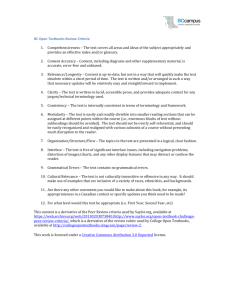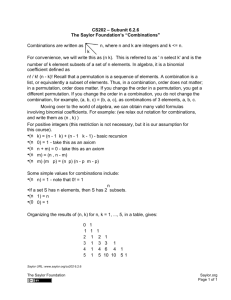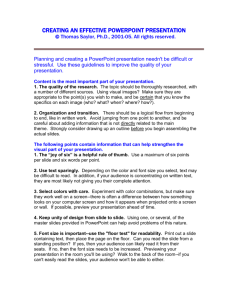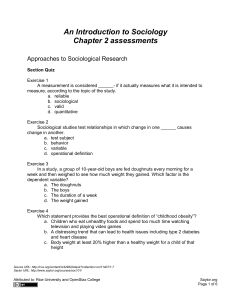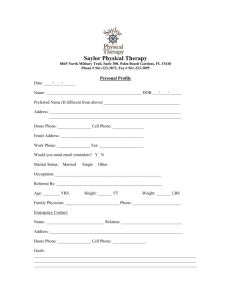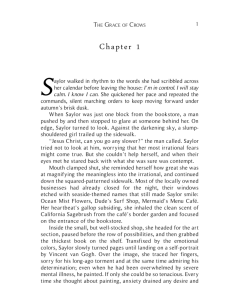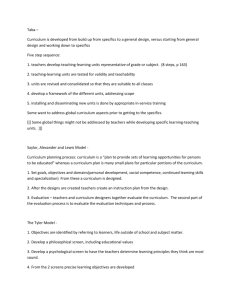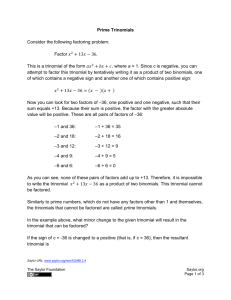Chapter 8 Memory
advertisement
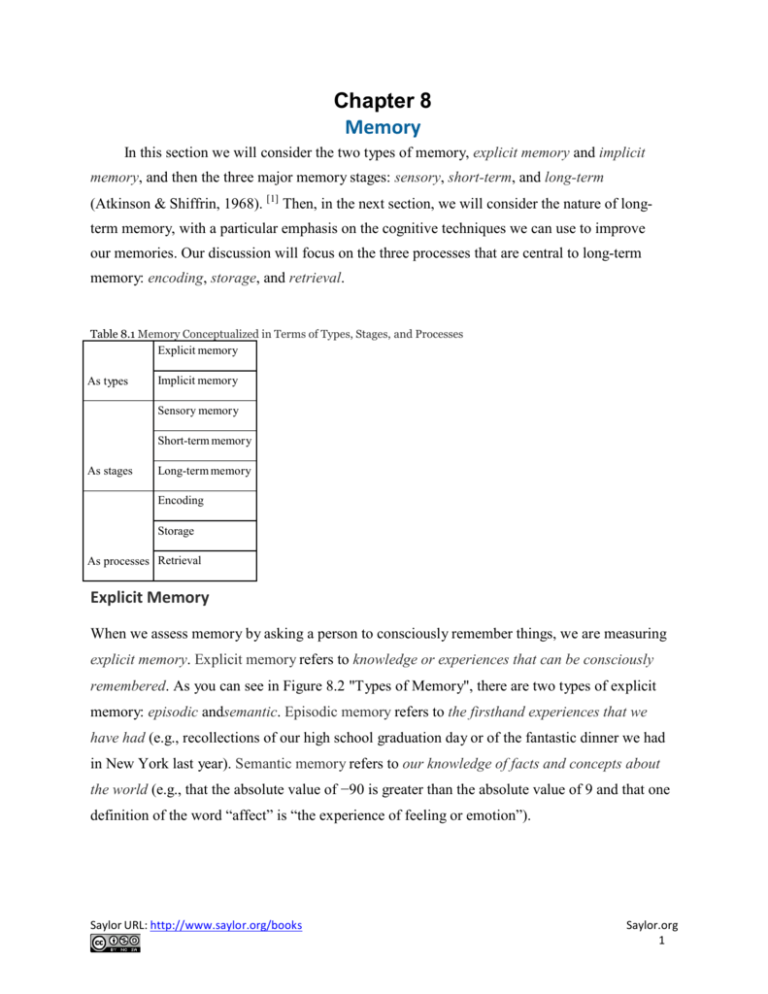
Chapter 8 Memory In this section we will consider the two types of memory, explicit memory and implicit memory, and then the three major memory stages: sensory, short-term, and long-term (Atkinson & Shiffrin, 1968). [1] Then, in the next section, we will consider the nature of longterm memory, with a particular emphasis on the cognitive techniques we can use to improve our memories. Our discussion will focus on the three processes that are central to long-term memory: encoding, storage, and retrieval. Table 8.1 Memory Conceptualized in Terms of Types, Stages, and Processes Explicit memory As types Implicit memory Sensory memory Short-term memory As stages Long-term memory Encoding Storage As processes Retrieval Explicit Memory When we assess memory by asking a person to consciously remember things, we are measuring explicit memory. Explicit memory refers to knowledge or experiences that can be consciously remembered. As you can see in Figure 8.2 "Types of Memory", there are two types of explicit memory: episodic andsemantic. Episodic memory refers to the firsthand experiences that we have had (e.g., recollections of our high school graduation day or of the fantastic dinner we had in New York last year). Semantic memory refers to our knowledge of facts and concepts about the world (e.g., that the absolute value of −90 is greater than the absolute value of 9 and that one definition of the word “affect” is “the experience of feeling or emotion”). Saylor URL: http://www.saylor.org/books Saylor.org 1 Figure 8.2 Types of Memory Explicit memory is assessed using measures in which the individual being tested must consciously attempt to remember the information. Arecall memory test is a measure of explicit memory that involves bringing from memory information that has previously been remembered. We rely on our recall memory when we take an essay test, because the test requires us to generate previously remembered information. A multiple-choice test is an example of a recognition memory test, a measure of explicit memory that involves determining whether information has been seen or learned before. Your own experiences taking tests will probably lead you to agree with the scientific research finding that recall is more difficult than recognition. Recall, such as required on essay tests, involves two steps: first generating an answer and then determining whether it seems to be the correct one. Recognition, as on multiple-choice test, only involves determining which item from a list seems most correct (Haist, Shimamura, & Squire, 1992). [2] Although they involve different processes, recall and recognition memory measures tend to be correlated. Students who do better on a multiple-choice exam will also, by and large, do better on an essay exam (Bridgeman & Morgan, 1996). [3] A third way of measuring memory is known as relearning (Nelson, 1985). [4]Measures of relearning (or savings) assess how much more quickly information is processed or learned when it is studied again after it has already been learned but then forgotten. If you have taken some French courses in the past, for instance, you might have forgotten most of the vocabulary you learned. But if you were to work on your French again, you’d learn the vocabulary much faster the second time around. Relearning can be a more sensitive measure of memory than either Saylor URL: http://www.saylor.org/books Saylor.org 2 recall or recognition because it allows assessing memory in terms of “how much” or “how fast” rather than simply “correct” versus “incorrect” responses. Relearning also allows us to measure memory for procedures like driving a car or playing a piano piece, as well as memory for facts and figures. Implicit Memory While explicit memory consists of the things that we can consciously report that we know, implicit memory refers to knowledge that we cannot consciously access. However, implicit memory is nevertheless exceedingly important to us because it has a direct effect on our behavior. Implicit memory refers to the influence of experience on behavior, even if the individual is not aware of those influences. As you can see in Figure 8.2 "Types of Memory", there are three general types of implicit memory: procedural memory, classical conditioning effects, and priming. Procedural memory refers to our often unexplainable knowledge of how to do things. When we walk from one place to another, speak to another person in English, dial a cell phone, or play a video game, we are using procedural memory. Procedural memory allows us to perform complex tasks, even though we may not be able to explain to others how we do them. There is no way to tell someone how to ride a bicycle; a person has to learn by doing it. The idea of implicit memory helps explain how infants are able to learn. The ability to crawl, walk, and talk are procedures, and these skills are easily and efficiently developed while we are children despite the fact that as adults we have no conscious memory of having learned them. A second type of implicit memory is classical conditioning effects, in which we learn, often without effort or awareness, to associate neutral stimuli (such as a sound or a light) with another stimulus (such as food), which creates a naturally occurring response, such as enjoyment or salivation. The memory for the association is demonstrated when the conditioned stimulus (the sound) begins to create the same response as the unconditioned stimulus (the food) did before the learning. The final type of implicit memory is known as priming, or changes in behavior as a result of experiences that have happened frequently or recently. Priming refers both to the activation of Saylor URL: http://www.saylor.org/books Saylor.org 3 knowledge (e.g., we can prime the concept of “kindness” by presenting people with words related to kindness) and to the influence of that activation on behavior (people who are primed with the concept of kindness may act more kindly). Research Focus: Priming Outside Awareness Influences Behavior One of the most important characteristics of implicit memories is that they are frequently formed and used automatically, without much effort or awareness on our part. In one demonstration of the automaticity and influence of priming effects, John Bargh and his colleagues (Bargh, Chen, & Burrows, 1996) [5] conducted a study in which they showed college students lists of five scrambled words, each of which they were to make into a sentence. Furthermore, for half of the research participants, the words were related to stereotypes of the elderly. These participants saw words such as the following: in Florida retired live people bingo man the forgetful plays The other half of the research participants also made sentences, but from words that had nothing to do with elderly stereotypes. The purpose of this task was to prime stereotypes of elderly people in memory for some of the participants but not for others. The experimenters then assessed whether the priming of elderly stereotypes would have any effect on the students’ behavior—and indeed it did. When the research participant had gathered all of his or her belongings, thinking that the experiment was over, the experimenter thanked him or her for participating and gave directions to the closest elevator. Then, without the participants knowing it, the experimenters recorded the amount of time that the participant spent walking from the doorway of the experimental room toward the elevator. As you can see in Figure 8.3 "Results From Bargh, Chen, and Burrows, 1996", participants who had made sentences using words related to elderly stereotypes took on the behaviors of the elderly—they walked significantly more slowly as they left the experimental room. Figure 8.3Results From Bargh, Chen, and Burrows, 1996 Saylor URL: http://www.saylor.org/books Saylor.org 4 Bargh, Chen, and Burrows (1996) found that priming words associated with the elderly made people walk more slowly. Source: Adapted from Bargh, J. A., Chen, M., & Burrows, L. (1996). Automaticity of social behavior: Direct effects of trait construct and stereotype activation on action. Journal of Personality & Social Psychology, 71, 230–244. To determine if these priming effects occurred out of the awareness of the participants, Bargh and his colleagues asked still another group of students to complete the priming task and then to indicate whether they thought the words they had used to make the sentences had any relationship to each other, or could possibly have influenced their behavior in any way. These students had no awareness of the possibility that the words might have been related to the elderly or could have influenced their behavior. Stages of Memory: Sensory, Short-Term, and Long-Term Memory Another way of understanding memory is to think about it in terms of stages that describe the length of time that information remains available to us. According to this approach (see Figure 8.4 "Memory Duration"), information begins in sensory memory, moves to short-term memory, and eventually moves to long-term memory. But not all information makes it through all three stages; most of it is forgotten. Whether the information moves from shorter-duration memory into longer-duration memory or whether it is lost from memory entirely depends on how the information is attended to and processed. Saylor URL: http://www.saylor.org/books Saylor.org 5 Figure 8.4 Memory Duration Memory can characterized in terms of stages—the length of time that information remains available to us. Source: Adapted from Atkinson, R. C., & Shiffrin, R. M. (1968). Human memory: A proposed system and its control processes. In K. Spence (Ed.), The psychology of learning and motivation (Vol. 2). Oxford, England: Academic Press. Sensory Memory Sensory memory refers to the brief storage of sensory information. Sensory memory is a memory buffer that lasts only very briefly and then, unless it is attended to and passed on for more processing, is forgotten. The purpose of sensory memory is to give the brain some time to process the incoming sensations, and to allow us to see the world as an unbroken stream of events rather than as individual pieces. Visual sensory memory is known as iconic memory. Iconic memory was first studied by the psychologist George Sperling (1960). [6] In his research, Sperling showed participants a display of letters in rows, similar to that shown in Figure 8.5 "Measuring Iconic Memory". However, the display lasted only about 50 milliseconds (1/20 of a second). Then, Sperling gave his participants a recall test in which they were asked to name all the letters that they could remember. On average, the participants could remember only about one-quarter of the letters that they had seen. Saylor URL: http://www.saylor.org/books Saylor.org 6 Figure 8.5 Measuring Iconic Memory Sperling (1960) showed his participants displays such as this one for only 1/20th of a second. He found that when he cued the participants to report one of the three rows of letters, they could do it, even if the cue was given shortly after the display had been removed. The research demonstrated the existence of iconic memory. Source: Adapted from Sperling, G. (1960). The information available in brief visual presentation. Psychological Monographs, 74(11), 1–29. Sperling reasoned that the participants had seen all the letters but could remember them only very briefly, making it impossible for them to report them all. To test this idea, in his next experiment he first showed the same letters, but then after the display had been removed, he signaled to the participants to report the letters from either the first, second, or third row. In this condition, the participants now reported almost all the letters in that row. This finding confirmed Sperling’s hunch: Participants had access to all of the letters in their iconic memories, and if the task was short enough, they were able to report on the part of the display he asked them to. The “short enough” is the length of iconic memory, which turns out to be about 250 milliseconds (¼ of a second). Saylor URL: http://www.saylor.org/books Saylor.org 7 Auditory sensory memory is known as echoic memory. In contrast to iconic memories, which decay very rapidly, echoic memories can last as long as 4 seconds (Cowan, Lichty, & Grove, 1990). [7] This is convenient as it allows you—among other things—to remember the words that you said at the beginning of a long sentence when you get to the end of it, and to take notes on your psychology professor’s most recent statement even after he or she has finished saying it. In some people iconic memory seems to last longer, a phenomenon known as eidetic imagery (or “photographic memory”) in which people can report details of an image over long periods of time. These people, who often suffer from psychological disorders such as autism, claim that they can “see” an image long after it has been presented, and can often report accurately on that image. There is also some evidence for eidetic memories in hearing; some people report that their echoic memories persist for unusually long periods of time. The composer Wolfgang Amadeus Mozart may have possessed eidetic memory for music, because even when he was very young and had not yet had a great deal of musical training, he could listen to long compositions and then play them back almost perfectly (Solomon, 1995). [8] Short-Term Memory Most of the information that gets into sensory memory is forgotten, but information that we turn our attention to, with the goal of remembering it, may pass into short-term memory. Shortterm memory (STM) is the place where small amounts of information can be temporarily kept for more than a few seconds but usually for less than one minute (Baddeley, Vallar, & Shallice, 1990). [9] Information in short-term memory is not stored permanently but rather becomes available for us to process, and the processes that we use to make sense of, modify, interpret, and store information in STM are known as working memory. Although it is called “memory,” working memory is not a store of memory like STM but rather a set of memory procedures or operations. Short-term memory is limited in both the length and the amount of information it can hold. Peterson and Peterson (1959) [10] found that when people were asked to remember a list of threeletter strings and then were immediately asked to perform a distracting task (counting backward by threes), the material was quickly forgotten (see Figure 8.6 "STM Decay"), such that by 18 Saylor URL: http://www.saylor.org/books Saylor.org 8 seconds it was virtually gone. Figure 8.6 STM Decay Peterson and Peterson (1959) found that information that was not rehearsed decayed quickly from memory. Source: Adapted from Peterson, L., & Peterson, M. J. (1959). Short-term retention of individual verbal items. Journal of Experimental Psychology, 58(3), 193–198. One way to prevent the decay of information from short-term memory is to use working memory to rehearse it. Maintenance rehearsal is the process of repeating information mentally or out loud with the goal of keeping it in memory. We engage in maintenance rehearsal to keep a something that we want to remember (e.g., a person’s name, e-mail address, or phone number) in mind long enough to write it down, use it, or potentially transfer it to long-term memory. Saylor URL: http://www.saylor.org/books Saylor.org 9 If we continue to rehearse information it will stay in STM until we stop rehearsing it, but there is also a capacity limit to STM. Try reading each of the following rows of numbers, one row at a time, at a rate of about one number each second. Then when you have finished each row, close your eyes and write down as many of the numbers as you can remember. 019 3586 10295 861059 1029384 75674834 657874104 6550423897 If you are like the average person, you will have found that on this test of working memory, known as a digit span test, you did pretty well up to about the fourth line, and then you started having trouble. I bet you missed some of the numbers in the last three rows, and did pretty poorly on the last one. The digit span of most adults is between five and nine digits, with an average of about seven. The cognitive psychologist George Miller (1956) [11] referred to “seven plus or minus two” pieces of information as the “magic number” in short-term memory. But if we can only hold a maximum of about nine digits in short-term memory, then how can we remember larger amounts Saylor URL: http://www.saylor.org/books Saylor.org 10 of information than this? For instance, how can we ever remember a 10-digit phone number long enough to dial it? One way we are able to expand our ability to remember things in STM is by using a memory technique called chunking. Chunking is the process of organizing information into smaller groupings (chunks), thereby increasing the number of items that can be held in STM. For instance, try to remember this string of 12 letters: XOFCBANNCVTM You probably won’t do that well because the number of letters is more than the magic number of seven. Now try again with this one: MTVCNNABCFOX Would it help you if I pointed out that the material in this string could be chunked into four sets of three letters each? I think it would, because then rather than remembering 12 letters, you would only have to remember the names of four television stations. In this case, chunking changes the number of items you have to remember from 12 to only four. [1] Atkinson, R. C., & Shiffrin, R. M. (1968). Human memory: A proposed system and its control processes. In K. Spence (Ed.), The psychology of learning and motivation (Vol. 2). Oxford, England: Academic Press. [2] Haist, F., Shimamura, A. P., & Squire, L. R. (1992). On the relationship between recall and recognition memory. Journal of Experimental Psychology: Learning, Memory, and Cognition, 18(4), 691–702. [3] Bridgeman, B., & Morgan, R. (1996). Success in college for students with discrepancies between performance on multiplechoice and essay tests. Journal of Educational Psychology, 88(2), 333–340. [4] Nelson, T. O. (1985). Ebbinghaus’s contribution to the measurement of retention: Savings during relearning. Journal of Experimental Psychology: Learning, Memory, and Cognition, 11(3), 472–478. [5] Bargh, J. A., Chen, M., & Burrows, L. (1996). Automaticity of social behavior: Direct effects of trait construct and stereotype activation on action. Journal of Personality & Social Psychology, 71, 230–244. [6] Sperling, G. (1960). The information available in brief visual presentation.Psychological Monographs, 74(11), 1–29. [7] Cowan, N., Lichty, W., & Grove, T. R. (1990). Properties of memory for unattended spoken syllables. Journal of Experimental Saylor URL: http://www.saylor.org/books Saylor.org 11 Psychology: Learning, Memory, and Cognition, 16(2), 258–268. [8] Solomon, M. (1995). Mozart: A life. New York, NY: Harper Perennial. [9] Baddeley, A. D., Vallar, G., & Shallice, T. (1990). The development of the concept of working memory: Implications and contributions of neuropsychology. In G. Vallar & T. Shallice (Eds.), Neuropsychological impairments of short-term memory (pp. 54–73). New York, NY: Cambridge University Press. [10] Peterson, L., & Peterson, M. J. (1959). Short-term retention of individual verbal items.Journal of Experimental Psychology, 58(3), 193–198. [11] Miller, G. A. (1956). The magical number seven, plus or minus two: Some limits on our capacity for processing information. Psychological Review, 63(2), 81–97. Although it is useful to hold information in sensory and short-term memory, we also rely on our long-term memory (LTM). We want to remember the name of the new boy in the class, the name of the movie we saw last week, and the material for our upcoming psychology test. Psychological research has produced a great deal of knowledge about long-term memory, and this research can be useful as you try to learn and remember new material (see Table 8.2 "Helpful Memory Techniques Based on Psychological Research"). In this section we will consider this question in terms of the types of processing that we do on the information we want to remember. To be successful, the information that we want to remember must be encoded and stored, and then retrieved. Table 8.2 Helpful Memory Techniques Based on Psychological Research Technique Description Useful example Use elaborative Material is better remembered if it is Think, for instance, “Proactive interference is like encoding. processed more fully. retroactive interference but it occurs in a forward manner.” Think, for instance, “I remember a time when I knew the answer to an exam question but couldn’t quite get it to come Make use of the self-reference Material is better remembered if it is to mind. This was an example of the tip-of-the-tongue effect. linked to thoughts about the self. phenomenon.” Review the material that you have already studied right Be aware of the Information that we have learned drops before the exam to increase the likelihood it will remain in forgetting curve. off rapidly with time. Saylor URL: http://www.saylor.org/books memory. Saylor.org 12 Information is learned better when it is Make use of the studied in shorter periods spaced over spacing effect. time. Study a little bit every day; do not cram at the last minute. We can continue to learn even after we Rely on think we know the information overlearning. perfectly. Use context- We have better retrieval when it occurs dependent in the same situation in which we If possible, study under conditions similar to the conditions retrieval. learned the material. in which you will take the exam. Use state- We have better retrieval when we are Many possibilities, but don’t study under the influence of dependent in the same psychological state as we drugs or alcohol, unless you plan to use them on the day of retrieval. were when we learned the material. Keep studying, even if you think you already have it down. the exam (which is not recommended). Encoding and Storage: How Our Perceptions Become Memories Encoding is the process by which we place the things that we experience into memory. Unless information is encoded, it cannot be remembered. I’m sure you’ve been to a party where you’ve been introduced to someone and then—maybe only seconds later—you realize that you do not remember the person’s name. Of course it’s not really surprising that you can’t remember the name, because you probably were distracted and you never encoded the name to begin with. Not everything we experience can or should be encoded. We tend to encode things that we need to remember and not bother to encode things that are irrelevant. Look at Figure 8.8 "Pennies in Different Styles", which shows different images of U.S. pennies. Can you tell which one is the real one? Nickerson and Adams (1979) [1] found that very few of the U.S. participants they tested could identify the right one. We see pennies a lot, but we don’t bother to encode their features. Saylor URL: http://www.saylor.org/books Saylor.org 13 Figure 8.8 Pennies in Different Styles Can you identify the “real” penny? We tend to have poor memory for things that don’t matter, even if we see them frequently. One way to improve our memory is to use better encoding strategies. Some ways of studying are more effective than others. Research has found that we are better able to remember information if we encode it in a meaningful way. When we engage in elaborative encoding we process new information in ways that make it more relevant or meaningful (Craik & Lockhart, 1972; Harris & Qualls, 2000). [2] Imagine that you are trying to remember the characteristics of the different schools of psychology we discussed in Chapter 1 "Introducing Psychology". Rather than simply trying to Saylor URL: http://www.saylor.org/books Saylor.org 14 remember the schools and their characteristics, you might try to relate the information to things you already know. For instance, you might try to remember the fundamentals of the cognitive school of psychology by linking the characteristics to the computer model. The cognitive school focuses on how information is input, processed, and retrieved, and you might think about how computers do pretty much the same thing. You might also try to organize the information into meaningful units. For instance, you might link the cognitive school to structuralism because both were concerned with mental processes. You also might try to use visual cues to help you remember the information. You might look at the image of Freud and imagine what he looked like as a child. That image might help you remember that childhood experiences were an important part of Freudian theory. Each person has his or her unique way of elaborating on information; the important thing is to try to develop unique and meaningful associations among the materials. Research Focus: Elaboration and Memory In an important study showing the effectiveness of elaborative encoding, Rogers, Kuiper, and Kirker (1977) [3] studied how people recalled information that they had learned under different processing conditions. All the participants were presented with the same list of 40 adjectives to learn, but through the use of random assignment, the participants were given one of four different sets of instructions about how to process the adjectives. Participants assigned to the structural task condition were asked to judge whether the word was printed in uppercase or lowercase letters. Participants in the phonemic task condition were asked whether or not the word rhymed with another given word. In the semantic task condition, the participants were asked if the word was a synonym of another word. And in the self-reference task condition, participants were asked to indicate whether or not the given adjective was or was not true of themselves. After completing the specified task, each participant was asked to recall as many adjectives as he or she could remember. Rogers and his colleagues hypothesized that different types of processing would have different effects on memory. As you can see in Figure 8.9 "Self-Reference Effect Results", the students in the self-reference task condition recalled significantly more adjectives than did students in any other condition. This finding, known as the self-reference effect, is powerful evidence that the self-concept helps us organize and remember information. The next time you are studying for an exam, you might try relating the material to your own experiences. The self-reference effect Saylor URL: http://www.saylor.org/books Saylor.org 15 suggests that doing so will help you better remember the information (Symons & Johnson, 1997).[4] Figure 8.9 Self-Reference Effect Results Participants recalled the same words significantly better when they were processed in relation to the self than when they were processed in other ways. Source: Adapted from Rogers, T. B., Kuiper, N. A., & Kirker, W. S. (1977). Self-reference and the encoding of personal information. Journal of Personality & Social Psychology, 35(9), 677–688. Using the Contributions of Hermann Ebbinghaus to Improve Your Memory Hermann Ebbinghaus (1850–1909) was a pioneer of the study of memory. In this section we consider three of his most important findings, each of which can help you improve your memory. In his research, in which he was the only research participant, Ebbinghaus practiced memorizing lists of nonsense syllables, such as the following: DIF, LAJ, LEQ, MUV, WYC, DAL, SEN, KEP, NUD You can imagine that because the material that he was trying to learn was not at all meaningful, it was not easy to do. Ebbinghaus plotted how many of the syllables he could remember against the time that had elapsed since he had studied them. He discovered an important principle of memory: Memory decays rapidly at first, but the amount of decay levels off with time (Figure 8.10 "Ebbinghaus Forgetting Curve"). Although Ebbinghaus looked at forgetting after days had elapsed, the same effect occurs on longer and shorter time scales. Bahrick (1984) [5] found that students who took a Spanish language course forgot about one half of the vocabulary that they Saylor URL: http://www.saylor.org/books Saylor.org 16 had learned within three years, but that after that time their memory remained pretty much constant. Forgetting also drops off quickly on a shorter time frame. This suggests that you should try to review the material that you have already studied right before you take an exam; that way, you will be more likely to remember the material during the exam. Figure 8.10 Ebbinghaus Forgetting Curve Hermann Ebbinghaus found that memory for information drops off rapidly at first but then levels off after time. Ebbinghaus also discovered another important principle of learning, known as the spacing effect. The spacing effect refers to the fact that learning is better when the same amount of study is spread out over periods of time than it is when it occurs closer together or at the same time. This means that even if you have only a limited amount of time to study, you’ll learn more if you study continually throughout the semester (a little bit every day is best) than if you wait to cram at the last minute before your exam (Figure 8.11 "Effects of Massed Versus Distributed Practice on Learning"). Another good strategy is to study and then wait as long as you can before you forget the material. Then review the information and again wait as long as you can before you forget it. (This probably will be a longer period of time than the first time.) Repeat and repeat again. The spacing effect is usually considered in terms of the difference between distributed practice (practice that is spread out over time) and massed practice (practice that comes in one block), with the former approach producing better memory. Saylor URL: http://www.saylor.org/books Saylor.org 17 Figure 8.11 Effects of Massed Versus Distributed Practice on Learning The spacing effect refers to the fact that memory is better when it is distributedrather than massed. Leslie, Lee Ann, and Nora all studied for four hours total, but the students who spread out their learning into smaller study sessions did better on the exam. Ebbinghaus also considered the role of overlearning—that is, continuing to practice and study even when we think that we have mastered the material. Ebbinghaus and other researchers have found that overlearning helps encoding (Driskell, Willis, & Copper, 1992). [6] Students frequently think that they have already mastered the material but then discover when they get to the exam that they have not. The point is clear: Try to keep studying and reviewing, even if you think you already know all the material. Retrieval Even when information has been adequately encoded and stored, it does not do us any good if we cannot retrieve it. Retrieval refers to the process of reactivating information that has been stored in memory. We are more likely to be able to retrieve items from memory when conditions at retrieval are similar to the conditions under which we encoded them. Context-dependent learning refers to an increase in retrieval when the external situation in which information is learned matches the Saylor URL: http://www.saylor.org/books Saylor.org 18 situation in which it is remembered. Godden and Baddeley (1975) [7] conducted a study to test this idea using scuba divers. They asked the divers to learn a list of words either when they were on land or when they were underwater. Then they tested the divers on their memory, either in the same or the opposite situation. As you can see in Figure 8.12 "Results From Godden and Baddeley, 1975", the divers’ memory was better when they were tested in the same context in which they had learned the words than when they were tested in the other context. Figure 8.12 Results From Godden and Baddeley, 1975 Godden and Baddeley (1975) tested the memory of scuba divers to learn and retrieve information in different contexts and found strong evidence for context-dependent learning. Source: Adapted from Godden, D. R., & Baddeley, A. D. (1975). Context-dependent memory in two natural environments: On land and underwater.British Journal of Psychology, 66(3), 325–331. You can see that context-dependent learning might also be important in improving your memory. For instance, you might want to try to study for an exam in a situation that is similar to the one in which you are going to take the exam. Whereas context-dependent learning refers to a match in the external situation between learning and remembering, state-dependent learning refers to superior retrieval of memories when the individual is in the same physiological or psychological state as during encoding. Research has found, for instance, that animals that learn a maze while under the influence of one drug tend to remember their learning better when they are tested under the influence of the same drug than Saylor URL: http://www.saylor.org/books Saylor.org 19 when they are tested without the drug (Jackson, Koek, & Colpaert, 1992). [8] And research with humans finds that bilinguals remember better when tested in the same language in which they learned the material (Marian & Kaushanskaya, 2007). [9] Mood states may also produce statedependent learning. People who learn information when they are in a bad (rather than a good) mood find it easier to recall these memories when they are tested while they are in a bad mood, and vice versa. It is easier to recall unpleasant memories than pleasant ones when we’re sad, and easier to recall pleasant memories than unpleasant ones when we’re happy (Bower, 1981; Eich, 2008). [10] Variations in the ability to retrieve information are also seen in the serial position curve. When we give people a list of words one at a time (e.g., on flashcards) and then ask them to recall them, the results look something like those in Figure 8.13 "The Serial Position Curve". People are able to retrieve more words that were presented to them at the beginning and the end of the list than they are words that were presented in the middle of the list. This pattern, known as the serial position curve, is caused by two retrieval phenomenon: The primacy effect refers to a tendency to better remember stimuli that are presented early in a list. The recency effect refers to the tendency to better remember stimuli that are presented later in a list. Figure 8.13 The Serial Position Curve The serial position curve is the result of both primacy effects and recency effects. Saylor URL: http://www.saylor.org/books Saylor.org 20 There are a number of explanations for primacy and recency effects, but one of them is in terms of the effects of rehearsal on short-term and long-term memory (Baddeley, Eysenck, & Anderson, 2009). [11] Because we can keep the last words that we learned in the presented list in short-term memory by rehearsing them before the memory test begins, they are relatively easily remembered. So the recency effect can be explained in terms of maintenance rehearsal in shortterm memory. And the primacy effect may also be due to rehearsal—when we hear the first word in the list we start to rehearse it, making it more likely that it will be moved from short-term to long-term memory. And the same is true for the other words that come early in the list. But for the words in the middle of the list, this rehearsal becomes much harder, making them less likely to be moved to LTM. In some cases our existing memories influence our new learning. This may occur either in a backward way or a forward way. Retroactive interference occurs when learning something new impairs our ability to retrieve information that was learned earlier. For example, if you have learned to program in one computer language, and then you learn to program in another similar one, you may start to make mistakes programming the first language that you never would have made before you learned the new one. In this case the new memories work backward (retroactively) to influence retrieval from memory that is already in place. In contrast to retroactive interference, proactive interference works in a forward direction. Proactive interference occurs when earlier learning impairs our ability to encode information that we try to learn later. For example, if we have learned French as a second language, this knowledge may make it more difficult, at least in some respects, to learn a third language (say Spanish), which involves similar but not identical vocabulary. The Biology of Memory Just as information is stored on digital media such as DVDs and flash drives, the information in LTM must be stored in the brain. The ability to maintain information in LTM involves a gradual strengthening of the connections among the neurons in the brain. When pathways in these neural networks are frequently and repeatedly fired, the synapses become more efficient in communicating with each other, and these changes create memory. This process, known as longterm potentiation (LTP), refers to the strengthening of the synaptic connections between neurons as result of frequent stimulation (Lynch, 2002). [12] Drugs that block LTP reduce learning, Saylor URL: http://www.saylor.org/books Saylor.org 21 whereas drugs that enhance LTP increase learning (Lynch et al., 1991). [13]Because the new patterns of activation in the synapses take time to develop, LTP happens gradually. The period of time in which LTP occurs and in which memories are stored is known as the period of consolidation. Memory is not confined to the cortex; it occurs through sophisticated interactions between new and old brain structures (Figure 8.17 "Schematic Image of Brain With Hippocampus, Amygdala, and Cerebellum Highlighted"). One of the most important brain regions in explicit memory is the hippocampus, which serves as a preprocessor and elaborator of information (Squire, 1992). [14] The hippocampus helps us encode information about spatial relationships, the context in which events were experienced, and the associations among memories (Eichenbaum, 1999). [15] The hippocampus also serves in part as a switching point that holds the memory for a short time and then directs the information to other parts of the brain, such as the cortex, to actually do the rehearsing, elaboration, and long-term storage (Jonides, Lacey, & Nee, 2005). [16] Without the hippocampus, which might be described as the brain’s “librarian,” our explicit memories would be inefficient and disorganized. While the hippocampus is handling explicit memory, the cerebellum and the amygdala are concentrating on implicit and emotional memories, respectively. Research shows that the cerebellum is more active when we are learning associations and in priming tasks, and animals and humans with damage to the cerebellum have more difficulty in classical conditioning studies (Krupa, Thompson, & Thompson, 1993; Woodruff-Pak, Goldenberg, Downey-Lamb, Boyko, & Lemieux, 2000). [17] The storage of many of our most important emotional memories, and particularly those related to fear, is initiated and controlled by the amygdala (Sigurdsson, Doyère, Cain, & LeDoux, 2007). [18] Evidence for the role of different brain structures in different types of memories comes in part from case studies of patients who suffer from amnesia, a memory disorder that involves the inability to remember information. As with memory interference effects, amnesia can work in either a forward or a backward direction, affecting retrieval or encoding. For people who suffer damage to the brain, for instance, as a result of a stroke or other trauma, the amnesia may work backward. The outcome is retrograde amnesia, a memory disorder that produces an inability to retrieve events that occurred before a given time. Demonstrating the fact that LTP takes time Saylor URL: http://www.saylor.org/books Saylor.org 22 (the process of consolidation), retrograde amnesia is usually more severe for memories that occurred just prior to the trauma than it is for older memories, and events that occurred just before the event that caused memory loss may never be recovered because they were never completely encoded. Organisms with damage to the hippocampus develop a type of amnesia that works in a forward direction to affect encoding, known as anterograde amnesia. Anterograde amnesia is the inability to transfer information from short-term into long-term memory, making it impossible to form new memories. One well-known case study was a man named Henry Gustav Molaison (before he died in 2008, he was referred to only as H. M.) who had parts of his hippocampus removed to reduce severe seizures (Corkin, Amaral, González, Johnson, & Hyman, 1997). [19] Following the operation, Molaison developed virtually complete anterograde amnesia. Although he could remember most of what had happened before the operation, and particularly what had occurred early in his life, he could no longer create new memories. Molaison was said to have read the same magazines over and over again without any awareness of having seen them before. Cases of anterograde amnesia also provide information about the brain structures involved in different types of memory (Bayley & Squire, 2005; Helmuth, 1999; Paller, 2004). [20] Although Molaison’s explicit memory was compromised because his hippocampus was damaged, his implicit memory was not (because his cerebellum was intact). He could learn to trace shapes in a mirror, a task that requires procedural memory, but he never had any explicit recollection of having performed this task or of the people who administered the test to him. Although some brain structures are particularly important in memory, this does not mean that all memories are stored in one place. The American psychologist Karl Lashley (1929) [21] attempted to determine where memories were stored in the brain by teaching rats how to run mazes, and then lesioning different brain structures to see if they were still able to complete the maze. This idea seemed straightforward, and Lashley expected to find that memory was stored in certain parts of the brain. But he discovered that no matter where he removed brain tissue, the rats retained at least some memory of the maze, leading him to conclude that memory isn’t located in a single place in the brain, but rather is distributed around it. Saylor URL: http://www.saylor.org/books Saylor.org 23 [1] Nickerson, R. S., & Adams, M. J. (1979). Long-term memory for a common object.Cognitive Psychology, 11(3), 287–307. [2] Craik, F. I., & Lockhart, R. S. (1972). Levels of processing: A framework for memory research. Journal of Verbal Learning & Verbal Behavior, 11(6), 671–684; Harris, J. L., & Qualls, C. D. (2000). The association of elaborative or maintenance rehearsal with age, reading comprehension and verbal working memory performance. Aphasiology, 14(5–6), 515–526. [3] Rogers, T. B., Kuiper, N. A., & Kirker, W. S. (1977). Self-reference and the encoding of personal information. Journal of Personality & Social Psychology, 35(9), 677–688. [4] Symons, C. S., & Johnson, B. T. (1997). The self-reference effect in memory: A meta-analysis. Psychological Bulletin, 121(3), 371–394. [5] Bahrick, H. P. (1984). Semantic memory content in permastore: Fifty years of memory for Spanish learned in school. Journal of Experimental Psychology: General, 113(1), 1–29. [6] Driskell, J. E., Willis, R. P., & Copper, C. (1992). Effect of overlearning on retention.Journal of Applied Psychology, 77(5), 615– 622. [7] Godden, D. R., & Baddeley, A. D. (1975). Context-dependent memory in two natural environments: On land and underwater. British Journal of Psychology, 66(3), 325–331. [8] Jackson, A., Koek, W., & Colpaert, F. (1992). NMDA antagonists make learning and recall state-dependent. Behavioural Pharmacology, 3(4), 415. [9] Marian, V. & Kaushanskaya, M. (2007). Language context guides memory content.Psychonomic Bulletin and Review, 14(5), 925–933. [10] Bower, G. H. (1981). Mood and memory. American Psychologist, 36, 129–148; Eich, E. (2008). Mood and memory at 26: Revisiting the idea of mood mediation in drug-dependent and place-dependent memory. In M. A. Gluck, J. R. Anderson, & S. M. Kosslyn (Eds.),Memory and mind: A festschrift for Gordon H. Bower (pp. 247–260). Mahwah, NJ: Lawrence Erlbaum Associates. [11] Baddeley, A., Eysenck, M. W., & Anderson, M. C. (2009). Memory. New York, NY: Psychology Press. [12] Lynch, G. (2002). Memory enhancement: The search for mechanism-based drugs.Nature Neuroscience, 5(Suppl.), 1035– 1038. [13] Lynch, G., Larson, J., Staubli, U., Ambros-Ingerson, J., Granger, R., Lister, R. G.,…Weingartner, H. J. (1991). Long-term potentiation and memory operations in cortical networks. In C. A. Wickliffe, M. Corballis, & G. White (Eds.), Perspectives on cognitive neuroscience (pp. 110–131). New York, NY: Oxford University Press. [14] Squire, L. R. (1992). Memory and the hippocampus: A synthesis from findings with rats, monkeys, and humans. Psychological Review, 99(2), 195–231. [15] Eichenbaum, H. (1999). Conscious awareness, memory, and the hippocampus. Nature Neuroscience, 2(9), 775–776. Saylor URL: http://www.saylor.org/books Saylor.org 24 [16] Jonides, J., Lacey, S. C., & Nee, D. E. (2005). Processes of working memory in mind and brain. Current Directions in Psychological Science, 14(1), 2–5. [17] Krupa, D. J., Thompson, J. K., & Thompson, R. F. (1993). Localization of a memory trace in the mammalian brain. Science, 260(5110), 989–991; Woodruff-Pak, D. S., Goldenberg, G., Downey-Lamb, M. M., Boyko, O. B., & Lemieux, S. K. (2000). Cerebellar volume in humans related to magnitude of classical conditioning. Neuroreport: For Rapid Communication of Neuroscience Research, 11(3), 609–615. [18] Sigurdsson, T., Doyère, V., Cain, C. K., & LeDoux, J. E. (2007). Long-term potentiation in the amygdala: A cellular mechanism of fear learning and memory. Neuropharmacology, 52(1), 215–227. [19] Corkin, S., Amaral, D. G., González, R. G., Johnson, K. A., & Hyman, B. T. (1997). H. M.’s medial temporal lobe lesion: Findings from magnetic resonance imaging. The Journal of Neuroscience, 17(10), 3964–3979. [20] Bayley, P. J., & Squire, L. R. (2005). Failure to acquire new semantic knowledge in patients with large medial temporal lobe lesions. Hippocampus, 15(2), 273–280; Helmuth, Laura. (1999). New role found for the hippocampus. Science, 285, 1339–1341; Paller, K. A. (2004). Electrical signals of memory and of the awareness of remembering. Current Directions in Psychological Science, 13(2), 49–55. [21] Lashley, K. S. (1929). The effects of cerebral lesions subsequent to the formation of the maze habit: Localization of the habit. In Brain mechanisms and intelligence: A quantitative study of injuries to the brain (pp. 86–108). Chicago, IL: University of Chicago Press. Saylor URL: http://www.saylor.org/books Saylor.org 25
